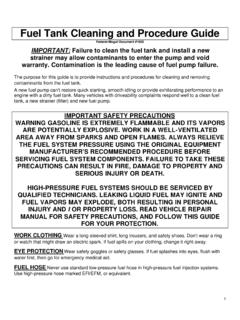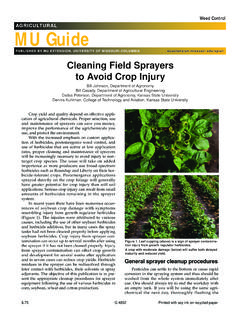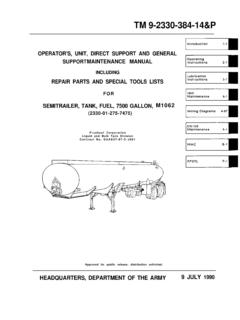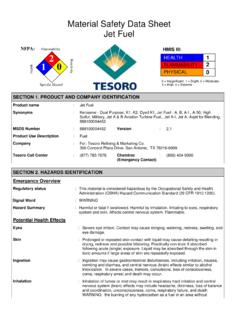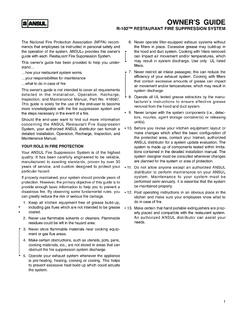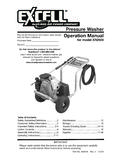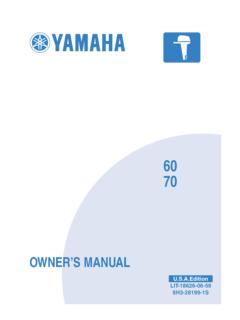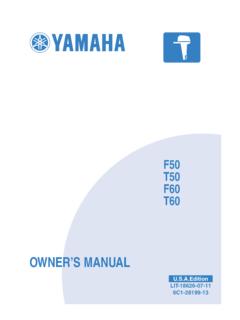Transcription of WEBER CARBURETOR TROUBLESHOOTING GUIDE
1 WEBER CARBURETOR TROUBLESHOOTING GUIDEThis GUIDE is to help pinpoint problems by diagnosing engine symptoms associated with specific vehicle operating conditions. The chart will GUIDE you step by step to help correct these successful TROUBLESHOOTING , please do the all steps suggested in the box, and any that follow inthe all of the suggestions in order, doing so will eliminateany secondary diagnosis directions completely (Cleaning, adjustment etc.) not do any other procedures other than the ones WEBER CARBURETOR has been manufactured using very high quality control standards. Through years of experience we have found that most carburetorproblems are caused by other engine components. Operating Conditions Engine SymptomsStalls/Rough/Slow/FloodRacesDoes notHesitatesPoorLowSmokesStart orDiesRunningRunningIdleCold5C 5D5C1 AStartingHot4A4A 5I1A 3B2G 5D5A2 AEngineCold5C1A 5D4A 5C5D5C5C 5 DTemperatureIdlingHot6G4A4A 5B2G 5D5A5B 5G 5 FCold3B4A5 DRunningHot2A 2H4A 6E3A5E 5 JCold2F 5H6A 6 DAccelerationHot2F 5H1A 2A6E5E 5J6 FPage 1 WEBER CARBURETOR TROUBLESHOOTING GUIDE FOR YOUR SAFETYR emember !
2 A Clean engine will make all work easier, accurate, and :NEVER:Use new hose clamps on fuel any dirt in the any cracked or missing the engine without proper( fuel , vacuum or coolant)filtration (Air and fuel Filters).Label any hose or wire before fuel to leak or spillUse an insulated connector for any any gasket surfacesOver tighten Jets or SYSTEMTo make sure that the ignition system is working correctly do steps 1 A - 1 Cwith the ignition NOTEMake sure that the battery is fully charged with no corrosion present on the terminals. A. Test the fuse for the ignition/charging circuit:If you do not have 12 volts at either side if the fuse, replace Check static ignition timing: Make sure that you do not have excessive free play at the distributor See if the distributor is 180 degrees out of time:Do a comparison to the cam timing or by reversing opposite pairs of ignition wires at the distributor cap.
3 DELIVERYTo make sure that the quality and supply of fuel to the CARBURETOR is correct,please so steps 2A - 2I . In our experience we have seen that fuel contaminatedwith water, dirt or rust is the major cause of CARBURETOR problems. Use fuel asfresh as NOTEOn vehicles equipped with electric fuel pumps. Most are notpowered with out the engine running or starter the fuel flow at the CARBURETOR by disconnecting the fuel supply hoseand directing the fuel flow into a small dry, clean can when the fuel pump NOTEDO NOT ALLOW ANY CHANCE OF A SPARK DISCONNECTTHE PRIMARY WIRE(S) )usually a small 16 Gauge wire)THAT CONNECTS THE GROUND (-) SIDE TERMINAL OF THE COIL TO THE DISTRIBUTOR ( OR SPARK BOX, IF SOLIDSTATE IGNITION).If fuel flow is adequate go to step 2 EIf fuel flow is not adequate go to step 2 BPage 2 WEBER CARBURETOR TROUBLESHOOTING GUIDE the fuel flow at the fuel filter and then at the fuel Pump:If fuel flow is not adequate go to step to see if the fuel tank is empty or if the lines are blocked.
4 They maybeblocked by dirt, ice, or other you have fuel in the tank and the lines are not blocked go to the vehicle is equipped with an electric fuel pump, test the pump by applying12 volts and a ground to the pump. If you have a mechanical pump, crank the engine over. If you do not have any fuel flow. Replace the pump. to see if the fuel is old or bad. ( If vehicle has been out of service for an extended period chances are that the fuel is bad.)If the fuel does not smell right:Try some fresh fuel a few drops at a time in the CARBURETOR NOTE AVOID fuel CONTACT WITH to see if the fuel is contaminated with rust or water:To check remove and empty out fuel filter (from the inlet side) into a clean,dry can , or if your vehicle has a drain plug on the fuel tank, empty some fuel from the tank into a clean, dry can.
5 Remember Water and fuel do not mix. the fuel pressure output with a fuel pressure gauge. If the fuel pressureexceeds psi, install a fuel pressure regulator. if the fuel Return and the fuel supply line are reversed. On some Webercarburetors that have a fuel return, remove the fitting one at a time from thecarb. The fuel return is restricted and the fuel inlet is totally open. sure that none of the fuel lines are crimped or kinked. make sure that engine is mechanically sound. Please do steps 3a - a compression check on all of the cylinders. Compression should be over125 psi per cylinder, and with in 10% of each other. if the intake manifold bolts or loose or you have a heated intake. Make sure that the heat source is most vehicles it is heated by water. Check with your Shop manual forthe heat source on your intake.
6 SYSTEMTo make sure that you do not have any vacuum leaks, check all vacuum operated devices, and connections to the intake manifold. Use the suggestedtests to NOTE THE VACUUM DEVICES ARE CONTROLS AND VALVES THAT REQUIREPage 3 WEBER CARBURETOR TROUBLESHOOTING GUIDESEALED VACUUM CONNECTIONS TO PROPERLY the vacuum system with a handheld vacuum pump is very helpful in finding leaking hoses and devices in the system away from the CARBURETOR .(Vacuum testers have an attached vacuum gauge to measure vacuum)Start at the CARBURETOR and work your way toward the engine, remove vacuumhoses one at a time. Be careful not to mix up any hoses. Plug the source of the vacuum and connect the vacuum pump to the sourceand test for any malfunctions in the TEST OTHER VACUUM CONTROLLED DEVICES:Distributor Advancelook for a change in the engine RetardTest with a timing ValveStalling will be normal when Valveengine will idle faster when PurgeIf the engine speed fluctuates with the hose disconnected,canister is fuel of fuel due to a problem in the tank vent orthe fuel tank is overfilled.
7 Go to 4 the method of pinching off hoses is helpful when you have hoses thatare leaking, such as air cleaner hoses and other the air inlet duct or air the engine and let it run at by one pinch off vacuum hoses with pliers and listen for a change in engine any suspected problems with the Vacuum TEST :HosesChoke stove air door ( thermostatic air cleaner)Power Brake BoosterHeater Controls, in all positionsCruise ControlAir Conditioning fast idle , ignition on A/C onHeadlight DoorsVacuum Reservoirs and amplifiersPCV Valve (idle should drop 50 RPM)Go To 4 CARBURETOR Cleaner to check for leaks. This will help you find defective gaskets and hidden leaks. IMPORTANT NOTE AVOID SPRAYING YOUR SELF READ ALL CAUTION LABELSAND WASH AFTER USINGR emove air inlet duct or air cleaner and plug any vacuum sources the engine idling, spray CARBURETOR cleaner into the air inlet of the CARBURETOR to determine the effect of until the engine returns to the previous CARBURETOR cleaner on the outside of the CARBURETOR and intake you have a vacuum leak the idle speed should have TEST :Some vacuum leakage at the throttle shaft is gaskets and and 4 WEBER CARBURETOR TROUBLESHOOTING GUIDE5 CARBURETORDo the following steps only after you have completed 1A, 2A, 3A and 4A.
8 This will help you save time and avoid creating any secondary our experiences most problems initially thought to be CARBURETOR problemsare those caused by other engine components. the choke and the throttle linkage:Check that you have free movement at the CARBURETOR with an assistant operatingthe gas pedal. In our experiences over tightened throttle shafts contribute tomany CARBURETOR problems. the Idle Speed Adjustment:With the engine at normal operating temperature, adjust to manufacturersspecs: turn adjustment screw in (clockwise) to raise the speed and out (counter-clockwise) to lower). the Fast Idle Adjustment:It may be necessary to perform this test first thing in the morning or after thevehicle has been allowed to cool the engine cold, press the gas pedal to the floor once and Vehicle.
9 Engine speed should be 2000 RPM - 2500 RPM after about10 seconds. Turn engine off. To adjust turn fast idle screw in to increase fast idle speed and out to decrease. Do not disturb the CARBURETOR linkageduring this adjustment. Without touching the gas pedal start engine againcheck engine RPM. If you have to readjust use the procedure above . the Automatic Choke choke is preset at the factory but in some cases it may be necessary to choke assembly must be cool ( below 68 F 20C) before attempting to make any adjustments. First fully rotate the throttle lever and release;Check for smooth operation; the choke plate should be all the way closed. Make a reference mark on the CARBURETOR and the choke where the two facesmeet. Loosen the three 7mm hex head screws one full turn.
10 While holdingthe throttle about one third open, adjust the closing tension on the chokeplates just fully close; then slightly increase the tension on the spring by continuing to rotate the thermostat 1/8" measured in the outer diameter of thethermostat. Tighten the three 7mm hex head screws without distorting theretainer ring; fast idle speed my need to be readjusted. If the choke platesdo not fully open after running the engine for three minutes go to step the choke thermostat assemblyThe electric choke terminal must have a key hot 12 volt source. The CARBURETOR is grounded to the engine by a metal to metal connection. If the vehicle was originally equipped with an electric choke and or an idle solenoid use that wire. If you do not have a wire present , splice into the wireleading from the ignition switch to the coil or ballast chokes must have a free flow of engine the idle cut-off solenoid (if equipped)With the solenoid on the CARBURETOR and ignition on and engine off,disconnect the wire from the solenoid and listen for a click; then with theengine idling, disconnect the wire leading to the solenoid.

